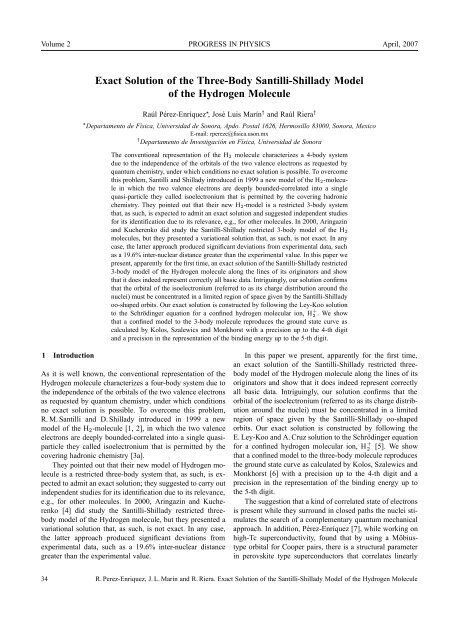ISSUE 2007 VOLUME 2 - The World of Mathematical Equations
ISSUE 2007 VOLUME 2 - The World of Mathematical Equations
ISSUE 2007 VOLUME 2 - The World of Mathematical Equations
You also want an ePaper? Increase the reach of your titles
YUMPU automatically turns print PDFs into web optimized ePapers that Google loves.
Volume 2 PROGRESS IN PHYSICS April, <strong>2007</strong><br />
1 Introduction<br />
Exact Solution <strong>of</strong> the Three-Body Santilli-Shillady Model<br />
<strong>of</strong> the Hydrogen Molecule<br />
Raúl Pérez-Enríquez ∗ , José Luis Marín † and Raúl Riera †<br />
∗ Departamento de Física, Universidad de Sonora, Apdo. Postal 1626, Hermosillo 83000, Sonora, Mexico<br />
E-mail: rpereze@fisica.uson.mx<br />
† Departamento de Investigación en Física, Universidad de Sonora<br />
<strong>The</strong> conventional representation <strong>of</strong> the H2 molecule characterizes a 4-body system<br />
due to the independence <strong>of</strong> the orbitals <strong>of</strong> the two valence electrons as requested by<br />
quantum chemistry, under which conditions no exact solution is possible. To overcome<br />
this problem, Santilli and Shillady introduced in 1999 a new model <strong>of</strong> the H2-molecule<br />
in which the two valence electrons are deeply bounded-correlated into a single<br />
quasi-particle they called isoelectronium that is permitted by the covering hadronic<br />
chemistry. <strong>The</strong>y pointed out that their new H2-model is a restricted 3-body system<br />
that, as such, is expected to admit an exact solution and suggested independent studies<br />
for its identification due to its relevance, e.g., for other molecules. In 2000, Aringazin<br />
and Kucherenko did study the Santilli-Shillady restricted 3-body model <strong>of</strong> the H2<br />
molecules, but they presented a variational solution that, as such, is not exact. In any<br />
case, the latter approach produced significant deviations from experimental data, such<br />
as a 19.6% inter-nuclear distance greater than the experimental value. In this paper we<br />
present, apparently for the first time, an exact solution <strong>of</strong> the Santilli-Shillady restricted<br />
3-body model <strong>of</strong> the Hydrogen molecule along the lines <strong>of</strong> its originators and show<br />
that it does indeed represent correctly all basic data. Intriguingly, our solution confirms<br />
that the orbital <strong>of</strong> the isoelectronium (referred to as its charge distribution around the<br />
nuclei) must be concentrated in a limited region <strong>of</strong> space given by the Santilli-Shillady<br />
oo-shaped orbits. Our exact solution is constructed by following the Ley-Koo solution<br />
to the Schrödinger equation for a confined hydrogen molecular ion, H +<br />
2 . We show<br />
that a confined model to the 3-body molecule reproduces the ground state curve as<br />
calculated by Kolos, Szalewics and Monkhorst with a precision up to the 4-th digit<br />
and a precision in the representation <strong>of</strong> the binding energy up to the 5-th digit.<br />
As it is well known, the conventional representation <strong>of</strong> the<br />
Hydrogen molecule characterizes a four-body system due to<br />
the independence <strong>of</strong> the orbitals <strong>of</strong> the two valence electrons<br />
as requested by quantum chemistry, under which conditions<br />
no exact solution is possible. To overcome this problem,<br />
R. M. Santilli and D. Shillady introduced in 1999 a new<br />
model <strong>of</strong> the H2-molecule [1, 2], in which the two valence<br />
electrons are deeply bounded-correlated into a single quasiparticle<br />
they called isoelectronium that is permitted by the<br />
covering hadronic chemistry [3a].<br />
<strong>The</strong>y pointed out that their new model <strong>of</strong> Hydrogen molecule<br />
is a restricted three-body system that, as such, is expected<br />
to admit an exact solution; they suggested to carry out<br />
independent studies for its identification due to its relevance,<br />
e.g., for other molecules. In 2000, Aringazin and Kucherenko<br />
[4] did study the Santilli-Shillady restricted threebody<br />
model <strong>of</strong> the Hydrogen molecule, but they presented a<br />
variational solution that, as such, is not exact. In any case,<br />
the latter approach produced significant deviations from<br />
experimental data, such as a 19.6% inter-nuclear distance<br />
greater than the experimental value.<br />
In this paper we present, apparently for the first time,<br />
an exact solution <strong>of</strong> the Santilli-Shillady restricted threebody<br />
model <strong>of</strong> the Hydrogen molecule along the lines <strong>of</strong> its<br />
originators and show that it does indeed represent correctly<br />
all basic data. Intriguingly, our solution confirms that the<br />
orbital <strong>of</strong> the isoelectronium (referred to as its charge distribution<br />
around the nuclei) must be concentrated in a limited<br />
region <strong>of</strong> space given by the Santilli-Shillady oo-shaped<br />
orbits. Our exact solution is constructed by following the<br />
E. Ley-Koo and A. Cruz solution to the Schrödinger equation<br />
for a confined hydrogen molecular ion, H + 2 [5]. We show<br />
that a confined model to the three-body molecule reproduces<br />
the ground state curve as calculated by Kolos, Szalewics and<br />
Monkhorst [6] with a precision up to the 4-th digit and a<br />
precision in the representation <strong>of</strong> the binding energy up to<br />
the 5-th digit.<br />
<strong>The</strong> suggestion that a kind <strong>of</strong> correlated state <strong>of</strong> electrons<br />
is present while they surround in closed paths the nuclei stimulates<br />
the search <strong>of</strong> a complementary quantum mechanical<br />
approach. In addition, Pérez-Enríquez [7], while working on<br />
high-Tc superconductivity, found that by using a Möbiustype<br />
orbital for Cooper pairs, there is a structural parameter<br />
in perovskite type superconductors that correlates linearly<br />
34 R. Perez-Enriquez, J. L. Marín and R. Riera. Exact Solution <strong>of</strong> the Santilli-Shillady Model <strong>of</strong> the Hydrogen Molecule

















